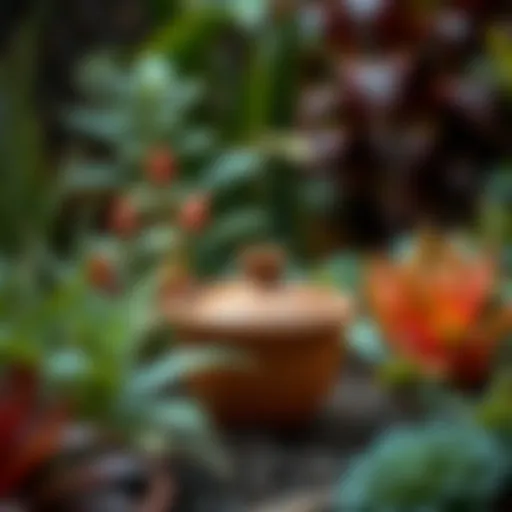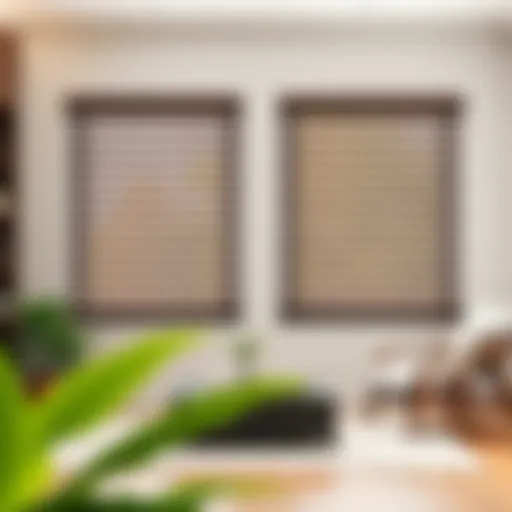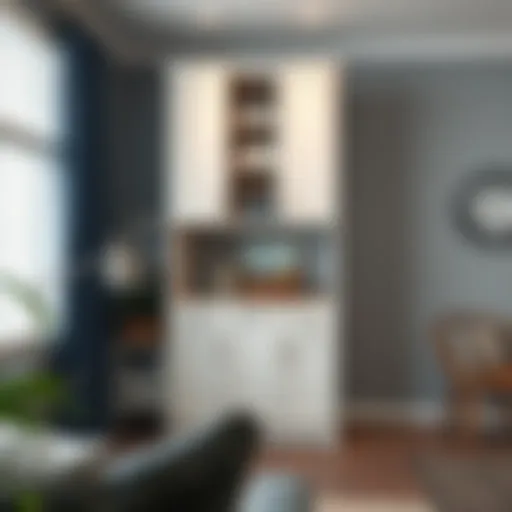Maximizing Your Shelves: A Guide to Furniture Utilization

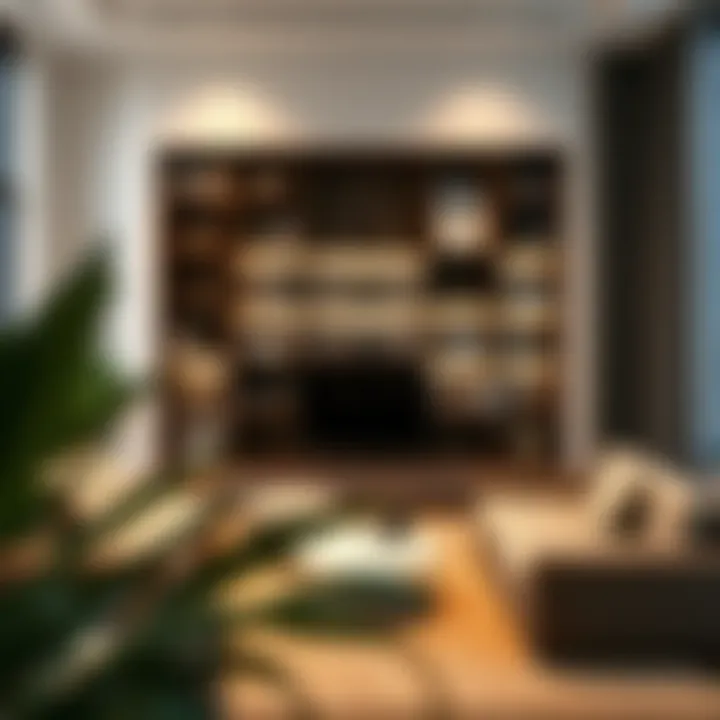
Intro
In the world of interior design, shelves often take on a transformative role that goes far beyond mere storage. Maximizing shelf space isn’t just about finding a place for your books or trinkets; it’s a strategic endeavor that blends functionality with style. A thoughtfully arranged shelf can enhance the aesthetic appeal of a room while also serving a practical function. Homeowners, designers, and DIY enthusiasts alike will find value in exploring how to maximize their shelving potential for improved organization and elegance.
The Role of Shelves in Interior Design
Shelves can support the overall design narrative of a space. While many furniture pieces merely occupy space, shelves provide a blank canvas for creativity—enabling personalization and showcasing unique items. Different types of shelves serve various purposes. From floating shelves that offer a sleek, modern touch to traditional bookcases that evoke warmth, there is a wide array of choices available.
Unpacking the Concept of Furniture Utilization
Furniture utilization isn’t just about cramming as much as possible into a room; it’s about understanding how the elements of space interact with one another. A well-designed shelf can create illusions in a room, making it feel larger or more cohesive. This idea of synergy between shelving and the rest of the décor is at the heart of strategic furniture utilization.
By understanding how to maximize these structures, we can enhance both the function and beauty of our homes. From selecting the right material that complements other furniture, to determining optimal placement based on lighting and accessibility, every decision counts. Let’s delve into the latest design trends surrounding shelves to provide a solid groundwork for the journey ahead.
Understanding the Role of Shelving in Interior Design
When it comes to interior design, the shelves do much more than just hold books and trinkets. They're vital components that shape the overall ambiance of a space. Shelving can bridge the gap between storage and style, serving dual purposes while enhancing the decorative elements of a room. Understanding their role in interior design is essential for anyone looking to curate a well-organized and aesthetically pleasing environment.
The Functional Aspects of Shelving
From storing everyday items to showcasing cherished possessions, shelves have a functional capacity that cannot be overlooked. Here are some of the ways that shelves contribute to practicality in a home:
- Efficient Use of Space: Shelves maximize vertical space, which is particularly significant in smaller areas. By utilizing the walls, one can keep the floor clear to create an illusion of a larger area.
- Organization: Shelving is a fundamental aspect of organization. Grouping like items together not only makes it easier to locate things but also imparts a sense of control over clutter. A well-ordered shelf can transform chaos into serenity.
- Customization: Adjustable shelves allow for versatility, accommodating everything from a collection of books to decorative plants. Homeowners can mix and match items, ensuring that the functionality adapts to their changing needs.
- Accessibility: Items placed on shelves are easily accessible. This makes it simple to retrieve what you need, whether it’s a beloved novel or a set of kitchen essentials.
By thinking of shelves as more than just places to stack items, one can appreciate how they serve fundamental functions that enhance day-to-day living.
Shelving as a Design Element
Shelving can also shine as a design feature, showcasing personal style and enhancing the aesthetic appeal of a space. Here are crucial points to ponder:
- Visual Interest: Shelves create focal points while adding dimension to walls. A beautifully arranged shelf can serve as an art piece. Not all shelving has to be utilitarian; some designs invite curiosity and conversation, breaking the monotony of flat surfaces.
- Material Variety: The choice of materials—wood, metal, glass—can reflect the interior style. Rustic wooden shelves might fit well in a cottage-style home, while sleek metal shelves align with modern industrial design.
- Color and Texture: Incorporating different colors and textures brings vibrancy. Brightly colored items or textured baskets can add pops of personality or soften harder edges.
- Personal Expression: Shelves provide an opportunity to showcase collections, artworks, or family photos, offering a glimpse into personal stories and interests, whether it’s travel memorabilia or literature collections.
In essence, shelving is both functional and a design companion. The balance of practicality and beauty is a cornerstone in effective interior design, ensuring that shelves do much more than just hold items—they enhance the whole atmosphere of the home.
Types of Shelving Solutions
When it comes to designing your space, understanding the different kinds of shelving solutions is essential. They aren't just about storage; they're a canvas for creativity. Each type of shelf has its own set of benefits and considerations that can greatly impact both function and style in your home. With the right choice, you can create not only a more organized environment but also an aesthetically pleasing one. This exploration will guide you through various options, unveiling how each type can be maximized to enhance your living areas.
Floating Shelves
Floating shelves are a fantastic option for those looking to save floor space while adding a touch of modern flair. These shelves attach directly to the wall, creating the illusion of items magically hovering. Their versatility makes them particularly appealing, whether in sleek, contemporary designs or rustic finishes.
- Benefits: They provide a minimalist look and are customizable to any length or width. You can easily choose the depth to suit your needs. While ideal for books, they can also serve as a home for decorative pieces, plants, or even framed photos.
- Consideration: Weight capacity is a real factor when selecting floating shelves. It's vital to consider what you plan to display; some shelves can only hold lightweight items. Installation can also be tricky. Proper anchoring into the wall studs is a must, or else you might find your prized possessions tumbling down!
Built-In Shelving
Built-in shelving provides a seamless look that often adds value to your home. These permanent fixtures can be tailored to fit your space, transforming even odd nooks into efficient storage areas. Integrated into walls or rooms, built-ins can serve multiple purposes from storage to a display for knick-knacks.
- Benefits: This type offers a polished and custom appearance that is often hard to replicate with standalone units. They can also maximize space in tricky areas, like corners or under stairs. Plus, you can decide the heights and widths based on what needs storing.
- Consideration: It's important to think about how this option affects your home's layout. They are, after all, a commitment. Once installed, altering them or removing them can be complex and costly. Therefore, planning according to current and future needs is key.
Bookcases and Display Units
Bookcases and display units are the workhorses of storage solutions. They tend to carry a traditional charm, and their structure allows for ample storage. Ranging from tall and grand to shorter and more compact, they provide a robust option for organizing books, memorabilia, and other decorative items.
- Benefits: Usually available in various styles, they can enhance the visual impact of your room. A well-designed bookcase can serve as a focal point. If you’re a book lover, having dedicated space for your collection can also spark joy every time you walk by.
- Consideration: These units often take up more space than other options, which may not be ideal for smaller rooms. Additionally, finding a bookcase that fits your desired aesthetic while being functional can sometimes be a lengthy pursuit.
Choosing the right type of shelving is all about assessing both your functional needs and the design aesthetic you want to curate in your space.
Materials Used in Shelving
Shelving isn't just about putting up boards and calling it a day. The materials you choose play a significant role in not only the aesthetics but also the functionality and durability of your shelves. Understanding the properties of various materials can help you create a cohesive design while ensuring that your shelves meet the specific needs of your space.
Different materials bring diverse benefits and considerations. For instance, wood offers a traditional charm but might need more maintenance over time, while metal provides unmatched strength. Glass adds a modern touch that often enhances the feeling of openness in a room. This section will delve into these materials, their characteristics, and how they can align with your interior goals.
Wood: Natural and Engineered
Wood can be a warm and inviting option for shelving. There’s a certain elegance to wooden shelves that can make a space feel homely, yet sophisticated. Natural wood has grains and knots that provide unique visual interest, making each piece one-of-a-kind. However, it can be susceptible to humidity and temperature changes, which might cause warping over time. Consider using engineered wood, like MDF or plywood, for a more stable alternative since it's designed to withstand variations in home environments.
Benefits of Wood Shelves:
- Versatility: They can fit into almost any design, be it rustic or modern.
- Easy to Customize: You can paint, stain, or leave them natural.
- Eco-Friendly Options: Sustainably sourced wood can significantly reduce environmental impact.
When deciding on wood, think about the finish too. A matte finish lends a more organic feel, while high-gloss can make a statement in contemporary spaces.
Metal Shelves: Strength and Versatility
Metal shelving is like the workhorse of the shelving world. It's sturdy and often can support more weight than wood or glass, making it perfect for heavier items. The industrial look of metal can suit modern designs, adding a raw, edgy touch to your interior. It's not all about looks, though. Metal is also less prone to warping, which can be a major advantage in areas like kitchens and garages where temperatures fluctuate.
Considerations for Metal Shelves Include:
- Material Type: Steel is the most robust, but aluminum offers lightweight options.
- Finish: Powder-coated finishes can prevent rust and add color, while a brushed finish can maintain an industrial feel.
- Design Flexibility: From open racks to intricate welded art pieces, there's an array of styles in the metal shelf category.

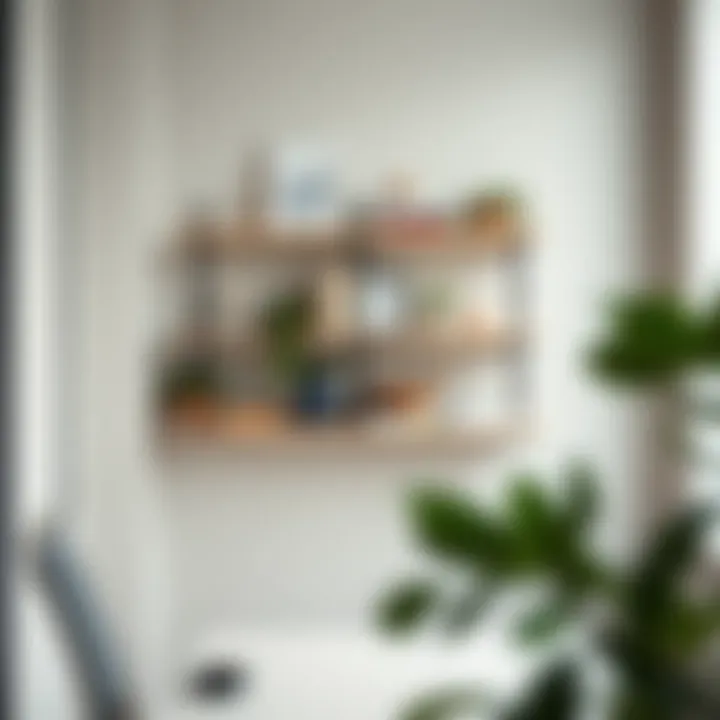
A word to the wise—ensure adequate wall support for weighty items to prevent accidents.
Glass Shelving: A Contemporary Touch
If you're aiming for a chic, modern vibe, glass shelving might be the way to go. Glass provides an unobtrusive look, perfect for smaller spaces where bulky furniture might overwhelm. This transparency allows other design elements to shine while offering a sleek storage solution.
Advantages of Glass Shelves:
- Visual Lightness: They can make a room feel bigger by rendering other items visible.
- Easy Cleaning: Generally, glass surfaces require minimal upkeep—just a simple wipe down.
- Customizable: Glass can be etched or colored to add a personal touch.
However, with glass comes caution. They need careful handling and should be appropriately installed to ensure safety, particularly in busy areas of the home.
"Shelving choices can amplify your decor's narrative, making the right material a key player in design success."
Designing Your Shelving Layout
When it comes to incorporating shelving within a home, the layout isn't just a matter of practicality; it's pivotal in transforming a house into a personalized sanctuary. Thoughtful arrangements serve dual purposes: they can enhance the aesthetic flow of a room while maximizing utilization of space. In this section, we will delve into specific elements and considerations that contribute to an effective shelving layout, revealing how the right design can cater to your needs.
Considerations for Small Spaces
In small living spaces, every square inch counts. It’s crucial to opt for shelving that doesn’t overwhelm but rather complements the room's dimensions. Vertical shelving tends to be a taller alternative that draws the eye upward, creating the illusion of higher ceilings. Additionally, using corner shelves can transforms wasted areas into useful storage solutions.
When utilizing shelves in compact areas, consider:
- Depth and Width: Shallow shelves can help maintain a spacious feel while providing necessary storage.
- Modularity: Systems that can be adjusted or added to allow flexibility as needs change.
- Multi-Functional Pieces: Shelves that can also serve as room dividers or seating can save space without skimping on style.
By guiding patterns through carefully planned layouts, even the tiniest spaces can feel surprisingly spacious and organized.
Balancing Aesthetics with Functionality
When designing your shelves, the key lies in striking a balance between beauty and utility. A shelf packed with knick-knacks might serve its purpose but can quickly look cluttered. Consider utilizing open shelving for visually appealing items while reserving closed storage for less attractive essentials.
In venues where aesthetics are paramount, you might ponder:
- Color Coordination: Cohesive colors across a group of displayed objects offer a pleasing, organized appearance.
- Layering Objects: Use varying heights and layers in arrangement—tall books interspersed with lower decorative pieces create visual interest.
- Lighting Effects: Integrating spotlights or LED strips can illuminate shelves, making both the items and the backdrop pop.
This thoughtful approach not only enhances the beauty of space but also cultivates functionality tailored for day-to-day life.
Creating a Focal Point with Shelves
Shelving can be a striking focal point when designed with intention. The arrangement doesn’t just house items; it becomes an expressive narrative space. For instance, a dramatically arranged bookshelf behind a couch can draw attention, inviting visitors to explore.
To elevate shelves into captivating focal points:
- Bold Backdrops: Consider painting or wallpapering the wall behind the shelves in captivating colors or patterns.
- Artful Displays: Curate a collection of personal artifacts—think travel souvenirs or family photos—to tell your story.
- Dramatic Scale: A large, distinct shelf unit can ground a room and become a key design feature.
"Shelves should do more than hold items—they should tell a story."
By crafting visual centroids, you not only enrich interior spaces but also facilitate conversation starters and reflections of personal style and journey.
Each decision regarding shelving layout—be it for small spaces, the balance of aesthetics, or the creation of focal points—plays an integral role in the visual and practical success of your interiors. Such careful planning yields a harmonious blend of beauty and convenience, illustrating the power of well-designed shelving.
Practical Uses of Shelving in Various Rooms
Shelving plays an integral role in maximizing space while adding functionality to various rooms in a home. It’s more than just stacking items; it’s about how these shelves can influence the feel and flow of a space. Understanding the practical uses of shelving in distinct areas allows homeowners to harness their potential fully, whether it’s for storage, display, or organization. When designed thoughtfully, shelves can transform any room into a well-organized and aesthetically pleasing environment.
Living Room: Style Meets Storage
In the living room, the shelves serve as a dual-purpose feature, blending style with practical storage solutions. Choosing a shelving unit that complements the overall decor can enhance the room's visual appeal. For instance, custom built-in shelves can provide specific spaces for books, decorative items, or family photographs, creating a personal touch that reflects the homeowner’s identity.
- Open Shelving: Using open shelves for display can make the room feel airier and more connected. It allows for easy access to items while showcasing artwork, cherished books, or even green plants.
- Color Coordination: Sticking to a consistent color scheme on shelves can tie the room together, making it feel more cohesive and well thought out. This not only organizes the space but also makes a design statement.
Kitchen: Organizing Essentials with Style
Kitchens are often bustling hubs of activity, and effective shelving can contribute immensely to tidiness. Open shelving in the kitchen promotes an open layout while ensuring essential items are within reach.
- Functional Arrangement: Pots, pans, and frequently used ingredients can occupy the shelves, minimizing clutter elsewhere. Magnetic strips or hooks can also be integrated to hang utensils, offering both style and organization.
- Decorative Elements: Keep the balance by incorporating stylish jars or neatly arranged spices to create a visual feast alongside functionality. Each item on display contributes to the kitchen's character.
Bedroom: Creating Relaxing Spaces
In the bedroom, shelving can play a pivotal role in nurturing a serene atmosphere. Ideal for housing bedtime reads, plants, or personal treasures, shelves help keep the space organized and personalized.
- Nightstand Alternatives: Floating shelves can replace traditional nightstands, providing just enough room for a lamp and a book, while keeping the floor space clear. This can make the bedroom appear more spacious and tranquil.
- Closet Organization: Shelving solutions can also be applied within closets to enhance storage capacity, allowing for structured placement of shoes, accessories, or seasonal clothes, contributing to a more peaceful retreat.
Home Office: Enhancing Productivity
For those working from home, a well-organized space can significantly affect productivity. Shelves can serve as vital storage for office supplies, books, and documents.
- Strategic Placement: Setting up shelving within arm's reach for essential materials improves workflow. Consider floating shelves above the desk for easy access to books or file organizers, reducing desk clutter and promoting focus.
- Inspiring Displays: Use the shelves to showcase motivational quotes, awards, or creative designs that inspire workflow. It adds a personal touch and transforms the workspace into a reflective environment, conducive to productivity.
"Shelving isn’t just about storage; it's about creating environments that function well and look beautiful."
Ultimately, the practical applications of shelving across different rooms can enhance both utility and aesthetic, ensuring that every corner of a home reflects the personality while remaining organized and efficient. By thoughtfully choosing and arranging shelves, homeowners can embrace the endless possibilities of optimizing their living spaces.
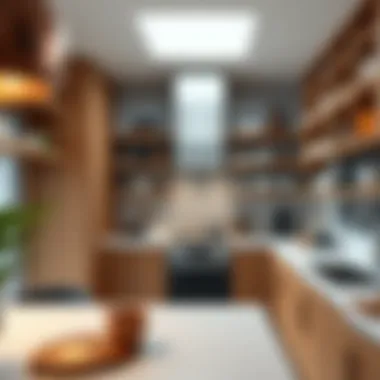

Displaying Items on Shelves
Displaying items on shelves is not merely about storage; it’s an opportunity to weave personal stories and aesthetics into your living spaces. Effective display can transform the mundane into the extraordinary, turning mere shelving into a stunning showcase of your interests, memories, and personality. This section dives into the importance of displaying items on shelves and the various elements that can help enhance both functionality and beauty.
Having well-curated and thoughtfully arranged shelves serves several purposes. First off, they can transform the overall vibe of a room. When items are displayed with intention, they invite not just organization but also a narrative. Whether it’s showcasing your collection of vintage books or your travels through a range of artifacts, each displayed piece contributes to the visual storytelling of your home.
Moreover, a well-organized shelf can enhance the functionality of your space. While you may have limited square footage, effectively utilizing vertical space through shelves allows you to maximize storage without sacrificing style. Keeping frequently used items within easy reach can also save time and energy, eliminating clutter on surfaces.
Curating Your Collection
Curating your collection isn’t just about putting things on display; it’s an art form. Begin by considering what you want to showcase. Think about items that hold significance—maybe travel souvenirs, family heirlooms, or art pieces that resonate with your style. One effective method is to use the principle of three; displaying items in groups of three often creates a visually pleasing balance.
It’s crucial to assess the color palette of your items. Aim to create a cohesive look; if you’re showcasing books, for example, consider arranging them by color or size to form blocks of color that draw the eye. This can add an intriguing visual rhythm to the shelves. Think also about scale. Mixing larger items, like a statement vase or sculpture, with smaller objects can create a sense of depth.
The Art of Arrangement
The arrangement of items can make or break the impact of your shelves. A few guidelines can help you achieve a harmonious look. Start with a focal point. This could be a larger item placed at the center or at one side of the shelf; it draws attention and creates a central theme.
Using varying heights can add dynamics. Stack books horizontally and place decorative objects on top, creating layers that invite the viewer's eye to explore. Don't forget white space—leaving some areas blank can allow the eye to rest and make the displayed items stand out more.
When it comes to themes, think about how items relate to one another. Does your shelf tell a story, or does it reflect your hobbies? If you're a music lover, consider mixing vinyl records with related memorabilia, like concert tickets or vintage instruments. This thematic arrangement not only beautifies but also adds personal meaning to your display.
Utilizing Space Efficiently
Efficiently utilizing space is paramount, especially in small or cluttered environments. Consider the height of your shelving; utilizing taller units can draw the eye upward, giving the illusion of a larger room. Don’t just stick to conventional shelves—think outside the box!
Floating shelves can be a lifesaver, particularly in tight spaces, providing both storage and a modern touch. Additionally, consider multi-functional pieces—like a bench with storage beneath—that can accommodate both seating and the display of items.
Always remain conscious of balance. While it may seem tempting to fill every inch of available space, remember that blank areas can create visual interest. Utilize bins or baskets on lower shelves to hide clutter while still making the area functional. This can keep your display organized, allowing the focus to remain on your chosen pieces.
"The beauty of any space reflects how its elements converse with each other—space, color, light, and texture harmonizing to tell meaningful stories."
In summary, displaying items on shelves is a powerful way to enhance the aesthetic and functional quality of your living space. Whether through thoughtful curation, skillful arrangement, or efficient use of space, each shelf becomes a canvas for expression and organization. By embracing this art form, you can create visually stunning displays that also serve a practical purpose.
Incorporating Shelves into Your Decor Style
Shelves play a pivotal role in the style and functionality of a home. They are not just about storage; they can enhance your space and harmonize with your dekor choices. When it comes to incorporating shelves, it’s essential to consider how they can reflect personal taste while offering practical benefits. Choosing the right style and arrangement can make all the difference in achieving your desired aesthetic. Let's dive into a few popular styles that fit seamlessly into various home environments.
Modern Minimalism
In the realm of contemporary decor, modern minimalism stands out. This style is marked by simplicity, clean lines, and a ‘less is more’ approach. Shelves in a minimalist design often feature neutral colors and natural materials such as light woods or metal. The aim here is to create an uncluttered look while allowing each piece on display to have its moment in the spotlight.
To achieve this look, you might consider:
- Floating shelves: Look sleek and create the illusion of more space.
- Muted decor items: Simple ceramics or monochrome books that don’t overwhelm the senses.
By incorporating these elements, you not only maximize functionality but also contribute to an atmosphere of calm and clarity.
Rustic Charm
If you lean towards a warmer, more inviting atmosphere, then rustic charm might be your go-to style. This approach emphasizes natural materials, earthy colors, and a cozy, lived-in feel. Wooden shelves with a rough-hewn finish perfectly complement traditional or farmhouse-style interiors. Think about repurposing reclaimed wood for even more character.
Consider these elements to evoke that rustic vibe:
- Open shelving in kitchens displaying vintage jars or farm-style dishware.
- Accent pieces: An eclectic collection of books, framed nature photography, or handcrafted items can elevate the warmth of the space.
It’s all about creating a display that feels genuine and narrative-driven, transporting people to another time and place.
Eclectic Mix and Match
For those who embrace diversity in their decor, the eclectic mix-and-match style provides a canvas for creativity. This approach celebrates compatibility across different aesthetics, harmonizing contrasting elements to create a unique statement. Shelves become a free-spirited gallery showcasing a collage of personal interests: travel souvenirs, art pieces, and curated knick-knacks.
To successfully navigate this style, you might want to:
- Select varying styles of shelves: Use a mix of bracketed shelves, floating units, or even vibrant colored bookcases.
- Display a variety of items: Combine books, art objects, plants, and even textiles on the same shelf to create visual interest and depth.
The power of this decor style lies in its ability to tell a story, displaying not just items but the experiences and passions of the homeowner.
Remember: Incorporating shelves into your decor style is not just about placing items on a shelf; it’s about creating a visual dialogue that reflects who you are and how you live.
Maintenance and Care for Shelves
Maintaining and caring for shelves is not just about keeping them looking good; it’s about enhancing their longevity and functionality. Shelves serve as both storage and decorative elements in a home, and if they aren’t properly looked after, they can quickly become an eyesore or even hazardous. Regular maintenance ensures that your shelving units remain stable and visually appealing while also extending their lifespan. The significance of understanding how to clean and care for your shelves can’t be overstated. Ensuring they are dust-free and in good condition not only adds to the aesthetic of your space but also contributes to a healthier home environment.
Cleaning Different Materials
Shelving can come in a variety of materials—from wood to metal to glass—and each type requires different cleaning techniques.
- Wood Shelves: Wood can be sensitive to harsh chemicals. A simple mixture of warm water and a mild dish soap works best. Use a soft cloth to wipe the surface, making sure to follow the grain of the wood. For tougher stains, a bit of white vinegar or lemon juice can do wonders. Make sure to dry them properly as excess moisture can warp the wood over time.
- Metal Shelves: Metal tends to attract fingerprints and dust. A microfiber cloth soaked in a mild cleaner or simply water usually suffices. Avoid abrasive cleaners as these can scratch the surface. If you have shelves with a powder-coated finish, you want to be extra gentle and steer clear of any substances that might damage that finish.
- Glass Shelves: Glass requires a light touch to avoid scratches. A mixture of vinegar and water makes for an excellent cleaner, cutting through dust and fingerprints effectively. Always use a soft cloth or paper towel to avoid scratching the glass.
It’s wise to tackle cleaning chores on a regular basis, preventing buildup of dust and grime that could otherwise lead to larger issues down the line.
"An ounce of prevention is worth a pound of cure." — Benjamin Franklin
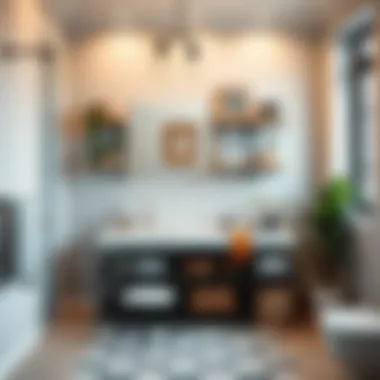
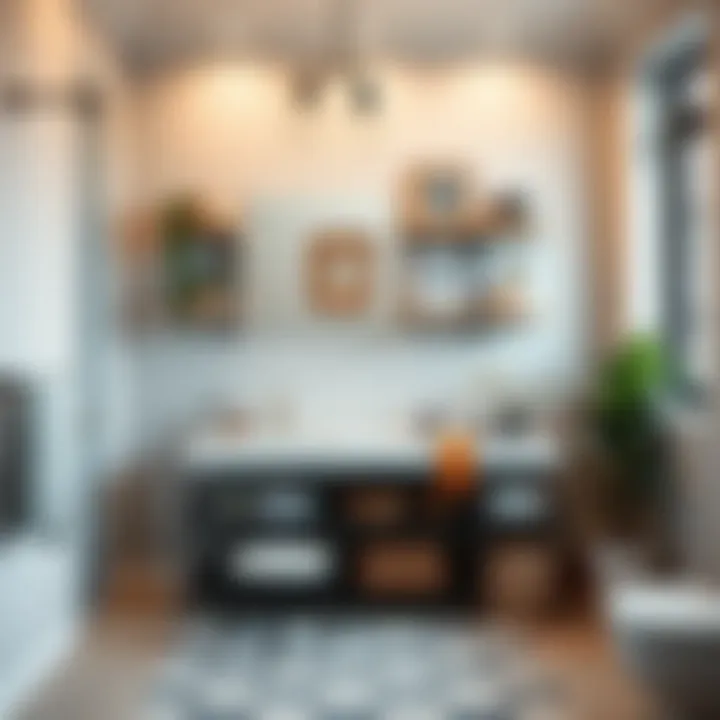
Preventing Damage and Wear
Each material has its vulnerabilities, and understanding how to prevent damage can save homeowners from costly fixes in the future.
- Temperature and Humidity Control: For wooden shelves, maintaining a steady environment is critical. Extreme temperatures and humidity levels can lead to warping, cracking, or even mold. Consider placing a hygrometer in the room to monitor levels, and avoid positioning shelves too close to windows or heaters.
- Weight Distribution: Stacking items evenly across a shelf is key. Uneven weight can cause sagging, which, over time, could compromise the structural integrity of your shelving. This applies even more to floating shelves that rely heavily on secure anchoring.
- Handling Fragile Items: If you have delicate items on your shelves—like glass figurines or ceramics—it's wise to use felt pads or rubber feet under them. This not only cushions them but also reduces the risk of cracking or chipping when dusting.
In summary, regular maintenance and a few smart practices can keep your shelving looking great and functioning well for many years. Taking the time to clean and care for your shelves is an investment in both the beauty and functionality of your space.
For further readings on home maintenance tips, you can refer to Wikipedia on Home Maintenance or visit resources on materials care at Britannica.
By following these simple guidelines, you can ensure that your shelves not only enhance the look of your home but remain sturdy and dependable as well.
Sustainable Shelving Options
In recent years, the emphasis on sustainability has resonated throughout the design community. The shift towards sustainable shelving options not only reflects a growing awareness of environmental issues but also highlights a greater desire for responsible consumption in furnishing our homes. Choosing sustainable shelving aligns with a conscientious approach to interior design while still maintaining aesthetic appeal. Its importance lies in reducing waste, promoting renewable materials, and ultimately creating a healthier home environment.
Eco-Friendly Materials
The backbone of sustainable shelving is the use of eco-friendly materials. These materials are sourced responsibly and often involve less harm to the environment during production. Common options include:
- Bamboo: Rapidly renewable and sturdy, bamboo stands out for its strength and minimal environmental impact. Some manufacturers transform bamboo into beautiful, long-lasting shelves that make an elegant statement.
- Reclaimed Wood: Sourcing wood from old buildings or furniture gives the material a second life. This not only minimizes waste but also adds a unique character to any shelving unit.
- Recycled Metal: Using recycled metals reduces the need for raw material extraction and the energy consumption associated with it. This choice can impart an industrial chic vibe, especially in urban design settings.
- Low-VOC Finishes: These are crucial for maintaining indoor air quality. Finishing materials with low volatile organic compounds help to minimize hazardous emissions while preserving the aesthetics of the shelves.
By opting for these materials, homeowners can create environments that reflect personal values while making informed choices that contribute to a greener future.
Upcycled and Reclaimed Shelves
Upcycling has taken the interior design world by storm. It involves repurposing items otherwise destined for the landfill into stylish, functional pieces of furniture. When it comes to shelves, this trend opens up an expansive realm of creativity.
- Reimagined Furniture: Old ladders, crates, or even shutters can be transformed into appealing shelf units with some imagination and a bit of elbow grease. This offers a personal touch, as each project can tell a story and showcase unique craftsmanship.
- Versatile Applications: Upcycled shelves find purpose in any space—from rustic kitchens to modern living rooms or eclectic home offices—blending seamlessly with various design styles. They bring forth a sense of history and authenticity.
- Reduction in Resource Use: By utilizing existing materials, we contribute to reducing the demand for new resources. This not only conserves trees but also lessens the carbon footprint associated with transporting new furniture.
Utilizing upcycled or reclaimed shelving options allows individuals to express their creativity while being responsible consumers. Not to mention, it encourages a deeper connection with the items we choose to incorporate into our homes.
"Sustainable shelving options are not just a trend; they represent a lifestyle choice that honors the Earth and elevates interior aesthetics."
As the design landscape evolves, the materials we choose to work with can impact both our homes and the planet significantly. For those embarking on a journey to enhance their interior spaces, embracing sustainable shelving options offers a path toward creativity, responsibility, and beauty.
Custom Shelving Solutions
Custom shelving solutions are gaining traction in interior design as they offer unique opportunities to transform spaces while maximizing functionality. Tailored designs not only address specific storage needs but also blend seamlessly with the aesthetic preferences of the homeowner. Investing in custom shelves means creating a tailored experience that can highlight personal style, cater to the particular demands of a space, and optimize storage capabilities.
Tailored Designs for Unique Spaces
Every room has its own personality, influenced by its size, shape, and layout. For instance, consider a cozy attic nook with slanted walls. Standard shelving might waste valuable space in such an area, but tailored shelves that fit snugly against the angles can turn an overlooked corner into a charming reading alcove. Similarly, large families often face challenges in maximizing storage without resorting to bulky furniture. Custom shelves can be designed to fill empty wall spaces, ensuring that each shelf’s dimensions are aligned with the items to be displayed, whether books, decorative pieces, or everyday essentials.
When planning a custom shelving project, it’s vital to keep the following aspects in mind:
- Measurements: Accurate measurements of the space help avoid nasty surprises during installation.
- Style Cohesion: Custom designs should harmonize with existing decor elements. A modern aesthetic may be complemented with sleek, minimalistic shelves, while traditional spaces may benefit from intricately carved wooden designs.
- Functionality: Think about the purpose of each shelf. Are they primarily for display or storage? This will inform depth, height, and spacing between shelves.
Inclusion of other elements like lighting, or even pegboards, can add flair and functionality, allowing for easy organization while providing visual interest.
DIY Shelving Projects
For the hands-on homeowner or the enthusiastic DIYer, crafting your own shelves can be a rewarding endeavor. Not only do DIY shelving projects offer significant savings, but they also allow for a personal touch that store-bought solutions cannot replicate.
Here are a few steps to guide you:
- Select Your Materials: Depending on your style, select wood, metal, or even reclaimed materials that suit the overall aesthetic of your space.
- Plan Your Design: Sketch a simple design, including dimensions and spacing, ensuring it meets your space requirements.
- Gather Tools: Basic tools like a drill, level, and saw (if making cuts) will be necessary.
- Install with Care: Ensure that shelves are anchored properly to the wall, preventing hazards due to sagging or collapsing.
"Creating something with your own hands not only saves money but adds a personal story to the decor."
Some of the popular DIY shelving ideas include:
- Floating Shelves: Simple and elegant, these can be mounted with concealed brackets for a clean look.
- Crate Shelves: Repurposing wooden crates creates a rustic, charming feel.
- Ladder Shelves: Easily made from wooden slats, they can lend a trendy, vertical dimension to any room.
For those looking for inspiration, websites like Pinterest and Instructables offer a plethora of resources and instructional guides.
The Future of Shelving in Interior Design
The significance of shelving in the realm of interior design can’t be overstated. As times change, so do the approaches to furniture utilization, and shelves are key players in this gradual evolution. In the coming years, shelves will not merely serve as storage facilitators but also become vital elements that bring together style, technology, and functionality in ever-innovative ways. This section aims to explore the emerging trends and technologies that could redefine how we perceive and use shelves in our homes.
Innovative Technologies and Trends
With the rise of smart home technology, shelves are no longer static entities in our living spaces. The advancement in materials and technology has enabled the integration of smart features into traditional shelving units. For instance, shelves equipped with built-in LEDs can enhance the aesthetic appeal of your decor while serving the practical purpose of illuminating spaces.
Moreover, customizable shelving systems are gaining traction, allowing individuals to adapt their shelves to their evolving needs, whether it’s by changing the dimensions or integrating modular components. Here's what to look forward to in terms of innovative shelving trends:
- Material Innovations: As sustainability takes a prime spot on consumers' minds, manufacturers are exploring biodegradable and recycled materials, making eco-friendly shelving more accessible.
- Smart Features: Imagine a shelf that not only holds books but also monitors the humidity of your indoor plants with integrated sensors. Such innovative designs meld beauty with tech, demonstrating that function doesn't have to sacrifice style.
- Adaptive Solutions: These systems can morph into different structures as needs change. One day, it may be a display area for collectibles; the next, it might serve as a functional office space.
As we navigate through these progressive landscapes of design, it’s essential to consider the implications of such adaptations. We will be living in a world where shelves become multi-purpose tools designed to complement and enhance our living environment rather than just filling empty walls.
Integrating Smart Home Features
The integration of smart features into shelving units brings a unique layer of sophistication to interior design. Homeowners today seek furniture that contributes to their lifestyle in a more interconnected manner. Smart shelves can do just that. Here are some examples of features that could become commonplace:
- Voice Activation: Shelves that can adjust lighting or even open certain compartments through voice commands make access and usability incredibly intuitive.
- App-Controlled Storage: Imagine managing your shelf content or adjusting the visibility of your items through a mobile app. This offers an exciting user experience, particularly in home offices or study spaces.
- Health Monitoring: Smart shelves that can track air quality or moisture levels can serve a dual purpose, enhancing both the decor and overall health of your indoor environment.
"As technology evolves, the integration of intelligent features in furniture designs will shape how we interact with the spaces we love."
When looking at these trends, it’s clear that the future of shelving is headed toward an era of dynamic design. With innovative ideas and technology at our fingertips, we have an opportunity to curate spaces that reflect personal style while seamlessly incorporating modern technology. The shelves of tomorrow could very well become the hubs of our homes, where technology meets creativity, and aesthetics marry functionality.





